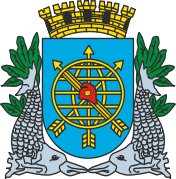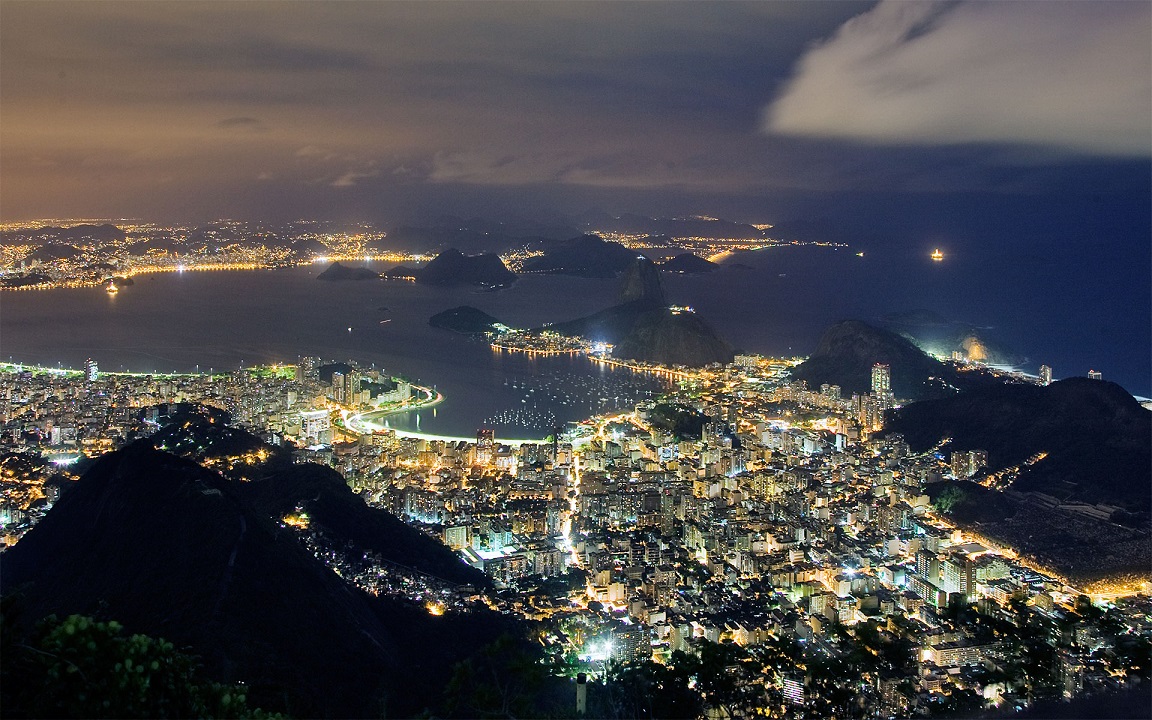Rio de Janeiro: Difference between revisions
| Line 836: | Line 836: | ||
=== <span style="color:#800000;"><u>Os Tribunais de os Cariocas: The Blood Courts of Rio</u> === | === <span style="color:#800000;"><u>Os Tribunais de os Cariocas: The Blood Courts of Rio</u> === | ||
==== [[File:Clan Toreador Hearldry.png|100px]] <span style="color:#800000;">'''O Tribunal de Rosas: The Toreador''' ==== | ==== [[File:Clan Toreador Hearldry.png|100px]] <span style="color:#800000;">'''O Tribunal de Rosas: The Toreador''' {6} ==== | ||
* <span style="color:#800000;"> -- [[Léonide Évariste de la Croix]] -- O Rei do Carnaval (the king of the carnival) | * <span style="color:#800000;"> -- [[Léonide Évariste de la Croix]] -- O Rei do Carnaval (the king of the carnival) | ||
* <span style="color:#800000;"> -- [[Efigénia Campos]] -- O Cavaleiro da Rosa (knight of the roses) | * <span style="color:#800000;"> -- [[Efigénia Campos]] -- O Cavaleiro da Rosa (knight of the roses) | ||
Revision as of 00:05, 17 February 2014
Brasão
Uma citação apropriada
Uma Introdução
- Rio de Janeiro is a city of contradictions for both the living and the dead. Its name is synonymous with sybaritic luxury, but the poverty of most of its seven million people is staggering, and tons of pollutants and human waste are dumped into its picturesque Guanabara Bay every day. Even the city's name is deceiving: It means "River of January" in Portuguese. There is no river here, though: the explorer Goncalho Coelho mistook the bay for the mouth of an estuary in 1502 and no one ever bothered to correct the mistake.
- Rio is a major financial center and a focal point for business and domestic commerce. Many South American corporate headquarters are located in the city, and most foreign companies have their primary headquarters within the city limits. The addition of the Galeao International Airport on nearby Governador Island has done nothing but add to the chaos.
- No longer Brazil's capital, Rio de Janeiro has spent 35 years slipping into a sort of luxurious lassitude. Its upper classes live in nigh-imperial splendor, supported by a booming tourism industry, which in turn fosters a glittering potpourri of nightclubs, discotheques and festivals. Vampires also flock to Rio: The countless tourists ensure that feeding in Rio is virtually effortless. And if elegant seduction of the innocent fails, vampires of less-choosy palates can always stroll down to Rio's expanses of squalid shantytowns and drag faceless victims out from corrugated tin shacks.
- Lasombra influence in Rio stretches back to Coelho's discovery of the site; after all, it was the legendary Archbishop Moncada who bankrolled his expedition. The Toreador arrived scant decades later, with the first exiled Huguenots to build a permanent settlement along the bay. Until gold and gems started flowing through Rio from Minas Gerais in the 1690s, the two clans spatted intermittently.
- With the money, however, came the real wars, wars which lasted until 1807 and the arrival of the exiled Portuguese court fleeing Napoleon. The influx of powerful Kindred of both clans ground the conflict to a quick stalemate, while the city's immense wealth and large transient population made peace a very appealing notion. Eventually, the truce grew into something that bears occasional resemblance to an alliance, based on the sacred tenet of not disturbing the goose that lays the golden (and emerald) eggs.
- So it is here, of all places, that Sabbat Lasombra and Camarilla Toreador have made an unspoken peace. The city has been tacitly declared Carnival for the Kindred: a free city, outside the sect wars and the Jyhad. All vampires are welcome here, provided that they leave their politics behind for the duration of their stay. That is not to say that Rio is safe for vampires - not by any stretch of the imagination; but rather that if a vampire kills another here, it is much more likely to be for reasons of business - or pleasure - than for political gain.
- Vampires of all stripes stroll through Rio's torrid byways, but certain clans are predominant. The Lasombra and Toreador still dominate Rio, conducting the city's affairs (or simply existing) with a style and elegance unknown to more staid regions. Brujah also walk here in abundance; some are descendants of slaves or holdovers from the nights of revolution, while others are drawn by Rio's Santeria rites and subversive blood cults. Malkavians cavort through the riotous night streets, their excesses ignored by the laughing herd; Tremere slink through the shadows, spying and selling their services; Setites hiss from alleyways, offering diversions to satisfy any and all tastes; and even Assamites can be found here, as assassins or as students of Capoiera (a Brazilian martial art).
- For Rio's mortal population, Carnival is the legendary festival that takes place four days prior to Ash Wednesday; for vampires, Carnival is something different. It is the official code of Rio, enforced by centuries-old vampires who, perhaps weary of the wars of their kind, have made the city a playground. In a city where death squads roam the streets to exterminate excess street urchins, there is certainly plenty of food for all. The city is a free port for vampiric goods and services, where deals can be struck and assignations can be made away from the watchful eyes of sect elders. It is in Rio that a Toreador can hire a Tzimisce to flesh-craft his dream lover, or a devout Lasombra can pray at the statue of Christ the Redeemer on Corcovado alongside a Wee Kirk Gangrel.
- As one night expect, such freedoms come at a great price. While the battle lines of the Jyhad have been temporarily erased here, for many vampires that simply means that now their own side can attempt to off them without retribution as well. Some of the child-hunting death squads are actually mercenary gangs of Kindred hunting others of their kind, taking bounties in vitae and gold from anyone willing to hire them. Still, that is part of the exhilaration of Rio: The samba-school dance-parade can hide a half-dozen murders, and Tzimisce "cleaners" take pride in how long they can prolong the process of feeding their victims, one dollop at a time, into the noisome sewage lines that run into the bay.
Humor e Tema: The Mood and Theme of the Marvelous City
Aparência
O clima do Rio
Rio has a tropical savannah climate that closely borders a tropical monsoon climate according to the Köppen climate classification, and is often characterized by long periods of heavy rain from December to March. In inland areas of the city, temperatures above 40 °C (104 °F) are common during the summer, though rarely for long periods, while maximum temperatures above 27 °C (81 °F) can occur on a monthly basis.
Along the coast, the breeze, blowing alternately onshore and offshore, moderates the temp. Because of its geographic situation, the city is often reached, especially during autumn and winter, by cold fronts advancing from Antarctica, causing frequent weather changes. It is mostly in summer that strong showers provoke catastrophic floods and landslides. The mountainous areas register greater rainfall since they constitute a barrier to the humid wind that comes from the Atlantic.
It is said that the city had frost in its past, but it was never confirmed. Some areas within Rio de Janeiro state have snow grains and ice pellets with an even frequency (popularly called granizo, or "hail", although it is in fact melted and refrozen snow falling in the form of a ball—true hail, rather than just icy snow along showers, is much less common). These phenomena are definitely not rare or limited to a few regions, happening in the metropolitan area (including western suburbs of the city itself) at least three times in the 21st century, said to be approximately each two decades or less in some regions. In other areas there is true snowfall more than once in each century, most commonly in the cities of Resende and Itatiaia (in lower latitudes than Rio de Janeiro, but much higher altitudes).
Roughly in the same suburbs corresponding to the March 2012 and February–March 2013 granizo falls (Nova Iguaçu and surrounding areas, including parts of Campo Grande and Bangu), there was a tornado-like phenomenon in January 2011, for the first time in the region's recorded history, causing structural damage and lasting blackouts, but no fatalities. The World Meteorological Organization alerts Brazil, specially its Southeastern region, that events as the catastrophic January 2011 Rio de Janeiro floods and mudslides are not an isolated phenomenon and that Brazil must be prepared for severe weather in the next years. "This (the early 2010s serial devastation in Rio de Janeiro's mesoregions Metropolitana do Rio de Janeiro and Sul Fluminense) was not an isolated event. The events in Brazil confirms a global trend that storms tend to be increasingly strong and in places where it did not take place with the same force", said Rupakumar Kolli, WMO expert on climatological phenomena. In early May 2013, winds registering above 90 km/h (56 mph) also caused lasting blackouts in 15 neighborhoods of the city and three surrounding municipalities, and it killed a person.
The average annual minimum temperature is 21 °C (70 °F), the average annual maximum temperature is 27 °C (81 °F), and the average annual temperature is 23 °C (73 °F). The average yearly precipitation is 1,175 mm (46.3 in). According to INMET, the minimum temperature recorded was 4.8 °C (40.6 °F) in July 1928, in the Campo dos Afonsos bairro (the Portuguese word for neighborhood), and the absolute maximum was 44 °C (111 °F) in February.[27] The lowest temperature ever registered in the 21st century was 8.1 °C (46.6 °F) in Vila Militar, July 2011.[28] Rio de Janeiro lags only after Cuiabá at being the hottest state capital outside Northern and Northeastern Brazil; temperatures below 14 °C (57 °F) happen in a yearly and those below than 11 °C (52 °F) happen in a less than yearly basis, so fazer frio ("making cold" i.e. "weather is getting cold") usually intends for temperatures below 21 °C (70 °F), present in a seasonally basis year-round and common place in mid-to-late autumn, winter and early spring nights.
Temperature also varies according to elevation, distance from the coast, and type of vegetation or land use. Winter, cold fronts and dawn/morning sea breezes bring mild temperatures; cold fronts, the Inter-topical Convergence Zone (in the form of winds from the Amazon Forest), the strongest sea-borne winds (often from an extra-topical cyclone) and summer evapotranspiration bring showers or storms. Thus the monsoon-like climate has dry and mild winters and springs, and very wet and warm summers and autumns. As a result, temperatures over 40 °C (104 °F), that happen about year-round but are more common during the summer, often mean the actual temperature feeling is over 50 °C (122 °F), when there is little wind and the relative humidity percentage is high. In such weather, avoiding dehydration (by high consumption of water and low consumption of sodium), over-exercising and direct exposure to the sun is recommended, especially for children and elders.
There is also a slightly greater seasonal difference in the incidence of solar radiation people receive in Rio de Janeiro in comparison to places in the Northern Hemisphere with similar climate and the same exact latitude as the Earth most closely approaches the Sun only 12 days after the Southern Hemisphere's summer solstice.
Average annual temperature of the sea is 23–24 °C (73–75 °F), from 22 °C (72 °F) in the period July–October to 26 °C (79 °F) in February and March. The wettest and driest months tend to be December and August respectively.
A economia do Rio
Rio de Janeiro has the second largest GDP of any city in Brazil, surpassed only by São Paulo. According to the IBGE, it was approximately US$ 201 billion in 2008, equivalent to 5.1% of the national total. The services sector comprises the largest portion of GDP (65.52%), followed by commerce (23.38%), industrial activities (11.06%) and agriculture (0.04%).
Benefiting from the federal capital position occupied by a long period (1763–1960), the town became a dynamic center administrative, financial, commercial and cultural. Greater Rio de Janeiro, as perceived by the IBGE, has a GDP of US$ 187.374.116.000, constituting the second largest hub of national wealth. Per capita GDP is US$ 11,786. It concentrates 68% of the state's economic strength and 7.91% of all goods and services produced in the country.
Taking into consideration the network of influence exerted by the urban metropolis (which covers 11.3% of the population), this share in GDP rises to 14.4%, according to a study released in October 2008 by the IBGE. For many years brings together the second largest industrial hub of Brazil, with oil refineries, shipbuilding industries, steel, metallurgy, petrochemical, gas, chemical, textile, printing, publishing, pharmaceutical, beverages, cement and furniture. However, the last decades indicated a sharp transformation in its economic profile, which is acquiring more and more shades of a major national hub of services and businesses. The Stock Exchange of Rio de Janeiro (BVRJ), which currently trades only government securities, was the first stock exchange founded in Brazil in 1845 and located in the central region.
Rio de Janeiro became an attractive place for companies to locate when it was the capital of Brazil, as important sectors of society and of the government were present in the city. The city was chosen as headquarters for state-owned companies such as Petrobras, Eletrobrás, Caixa Econômica Federal and Vale (which was privatized in the 1990s). After the transfer of the capital to Brasília, in 1960, it kept attracting more companies, especially after the discovery of oil in the Campos Basin, which produces most of the total oil production of Brazil. This made many oil and gas companies to be based in Rio de Janeiro, such as the Brazilian branches of Shell, EBX and Esso. The headquarters of BNDES, an important state institution, is also in Rio de Janeiro. The city is also the headquarters of large telecom companies, such as Intelig, Oi and Embratel.
Rio ranks second nationally in industrial production and second financial and service center, trailing only São Paulo. The city's industries produce processed foods, chemicals, petroleum products, pharmaceuticals, metal products, ships, textiles, clothing, and furniture. The service sector dominates the economy, however, and includes banking and the second most active stock market in Brazil, the Bolsa da Valores do Brasil. Tourism and entertainment are other key aspects of the city's economic life and the city is the nation's top tourist attraction for both Brazilians and foreigners.
Because it was once the national capital, Rio de Janeiro was chosen as the site for the headquarters of many private, national, multinational, and state corporations, even when their factories were located in other cities or states. Despite the transfer of the capital to Brasília, many of these headquarters remained within the Rio metropolitan area, including those of Petrobrás, the state oil company, and the National Economic and Social Development Bank, a federal investment bank.
A newer electronics and computer sector has been added to the older industries of metallurgy, engineering, and printing and publishing. Other manufacturing sectors focus on the production of shipyard-related materials, apparel and footwear, textiles, nonmetallic mineral products, food and beverages, chemicals, and pharmaceuticals. Construction, also an important activity, provides a significant source of employment for large numbers of unskilled workers and is buoyed by the number of seasonal residents who build second homes in the Greater Rio de Janeiro area.
To attract industry, the state government has designated certain areas on the outskirts of the city as industrial districts where infrastructure is provided and land sales are made under special conditions. Oil and natural gas from fields off the northern coast of Rio de Janeiro state are a major asset used for developing manufacturing activities in Rio's metropolitan area, enabling it to compete with other major cities for new investment in industry.
As with manufacturing, Rio is an important financial centre, second only to São Paulo in volume of business in financial markets and in banking. Its securities market, although declining in significance relative to São Paulo, is still of major importance. Owing to the proximity of Rio's port facilities, many of Brazil's export-import companies are headquartered in the city. In Greater Rio, which has one of the highest per capita incomes in Brazil, retail trade is substantial. Many of the most important retail stores are located in the Centre, but others are scattered throughout the commercial areas of the other districts, where shopping centres, supermarkets, and other retail businesses handle a large volume of consumer trade.
Major Brazilian entertainment and media organizations are based in Rio de Janeiro like Organizações Globo and also some of Brazil's major newspapers: Jornal do Brasil, O Dia, and Business Rio. Major international pharmaceutical companies have their Brazilian headquarters in Rio such as: Merck, Roche, Arrow, Darrow, Baxter, Mayne, and Mappel.
Rio de Janeiro is the 2nd richest city in Brazil, behind São Paulo and the 30th richest city in the world with a GDP of R$ 201,9 billion in 2010. The per capita income for the city was R$22,903 in 2007 (around US$14,630). According to Mercer's city rankings of cost of living for expatriate employees, Rio de Janeiro ranks 12th among the most expensive cities in the world in 2011, up from the 29th position in 2010, just behind São Paulo (ranked 10th), and ahead of London, Paris, Milan, and New York City. Rio also has the most expensive hotel rates in Brazil, and the daily rate of its five star hotels are the second most expensive in the world after only NYC.
A geografia do Rio
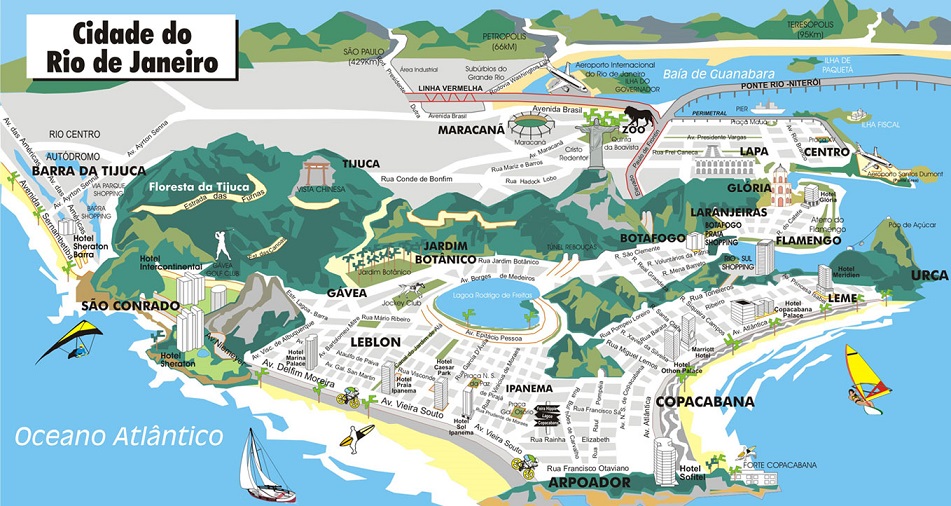
Rio de Janeiro is on a strip of Brazil's Atlantic coast, close to the Tropic of Capricorn, where the shoreline is oriented east–west. Facing largely south, the city was founded on an inlet of this stretch of the coast, Guanabara Bay (Baía de Guanabara), and its entrance is marked by a point of land called Sugar Loaf (Pão de Açúcar)—a "calling card" of the city.
The Center (Centro), the core of Rio, lies on the plains of the western shore of Guanabara Bay. The greater portion of the city, commonly referred to as the North Zone (Zona Norte), extends to the northwest on plains composed of marine and continental sediments and on hills and several rocky mountains. The South Zone (Zona Sul) of the city, reaching the beaches fringing the open sea, is cut off from the Center and from the North Zone by coastal mountains. These mountains and hills are offshoots of the Serra do Mar to the northwest, the ancient gneiss-granite mountain chain that forms the southern slopes of the Brazilian Highlands. The large West Zone (Zona Oeste), long cut off by the mountainous terrain, had been made accessible by new roads and tunnels by the end of the 20th century.
The population of the city of Rio de Janeiro, occupying an area of 1,182.3 square kilometres (456.5 sq mi), is about 6,000,000. The population of the greater metropolitan area is estimated at 11–13.5 million. It was Brazil's capital until 1960, when Brasília took its place. Residents of the city are known as cariocas. The official song of Rio is "Cidade Maravilhosa", by composer André Filho.
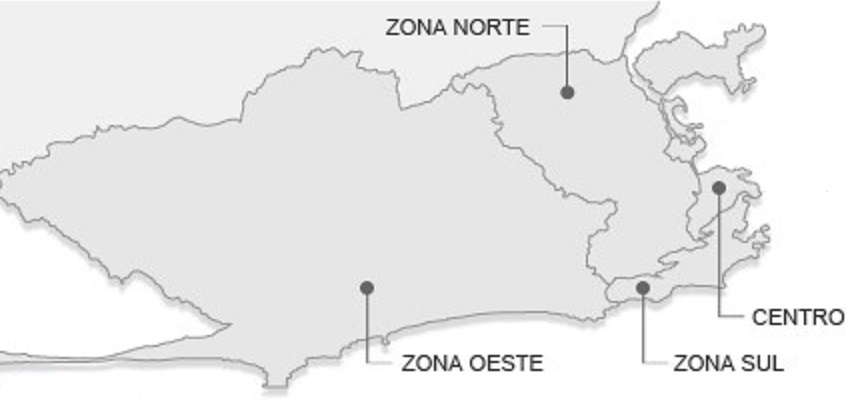
Centro
Centro is the historic core of the city, as well as its financial center. Sites of interest include the Paço Imperial, built during colonial times to serve as a residence for the Portuguese governors of Brazil; many historic churches, such as the Candelária Church, (the former cathedral), Sao Jose, Santa Lucia, Nossa Senhora do Carmo, Santa Rita, San Francisco de Paula, and the monasteries of Santo Antonio and Sao Bento. The Centro also houses the modern concrete Rio de Janeiro Cathedral. Around the Cinelândia square, there are several landmarks of the Belle Époque of Rio, such as the Municipal Theatre and the National Library building. Among its several museums, the Museu Nacional de Belas Artes (National Museum of Fine Arts) and the Museu Histórico Nacional (National Historical Museum) are the most important. Other important historical attractions in central Rio include its Passeio Público, an 18th-century public garden. Major streets include Avenida Rio Branco and Avenida Vargas, both constructed, in 1906 and 1942 respectively, by destroying large swaths of the colonial city. A number of colonial streets, such as Rua do Ouvidor and Uruguayana, have long been pedestrian spaces, and the popular Saara shopping district has been pedestrianized more recently.
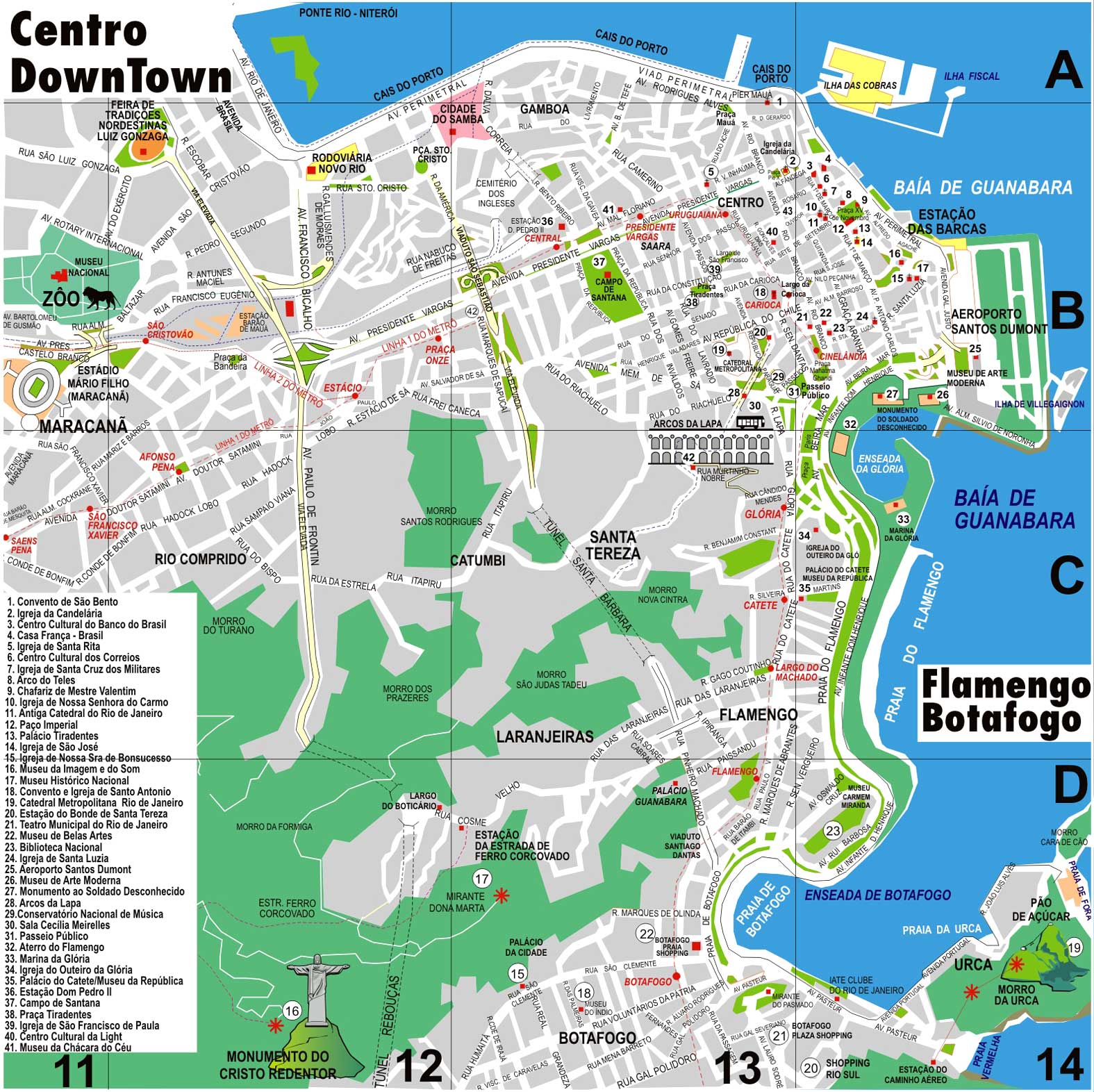
Places of Interest
- -- Avenida Rio Branco
- -- Avenida Vargas
- -- Candelária Church
- -- Cinelândia Square
- -- Municipal Theatre
- -- Museu Histórico Nacional -- National Historical Museum
- -- Museu Nacional de Belas Artes -- National Museum of Fine Arts
- -- National Library
- -- Paço Imperial
- -- Passeio Público -- An 18th-century public garden.
- -- Rio de Janeiro Cathedral
- -- Rua do Ouvidor
- -- Rue Uruguayana
- -- Saara -- A popular shopping district.
Zona Sul

The South Zone of Rio de Janeiro is composed of several districts, among which are São Conrado, Leblon, Ipanema, Arpoador, Copacabana, and Leme, which compose Rio's famous Atlantic beach coastline. Other districts in the South Zone are Glória, Catete, Flamengo, Botafogo, and Urca, which border Guanabara Bay and Santa Teresa, Cosme Velho, Laranjeiras, Humaitá, Lagoa, Jardim Botânico, and Gávea.
It is the wealthiest part of the city and the best known overseas; the neighborhood of Leblon in particular has the most expensive real estate in all of South America.
The neighbourhood of Copacabana beach hosts one of the world's most spectacular New Year's Eve parties ("Reveillon"), as more than two million revelers crowd onto the sands to watch the fireworks display. As of 2001, the fireworks have been launched from boats, to improve the safety of the event. To the north of Leme, and at the entrance to Guanabara Bay, is the district of Urca and the Sugarloaf Mountain ('Pão de Açúcar'), whose name describes the famous mountain rising out of the sea. The summit can be reached via a two-stage cable car trip from Praia Vermelha, with the intermediate stop on Morro da Urca. It offers views second only to Corcovado mountain.
Hang gliding is a popular activity on the Pedra Bonita (literally, "Beautiful Rock"). After a short flight, gliders land on the Praia do Pepino (Pepino, or "cucumber", Beach) in São Conrado.
Since 1961, the Tijuca National Park (Parque Nacional da Tijuca), the largest city-surrounded urban forest and the second largest urban forest in the world, has been a National Park. The largest urban forest in the world is the Floresta da Pedra Branca (White Rock Forest), which is also located in the West Zone of Rio de Janeiro. The Pontifical Catholic University of Rio (Pontifícia Universidade Católica do Rio de Janeiro or PUC-Rio), Brazil's top private university, is located at the edge of the forest, in the Gávea district. The 1984 film "Blame It on Rio" was filmed nearby, with the rental house used by the story's characters sitting at the edge of the forest on a mountain overlooking the famous beaches.
Zona Norte
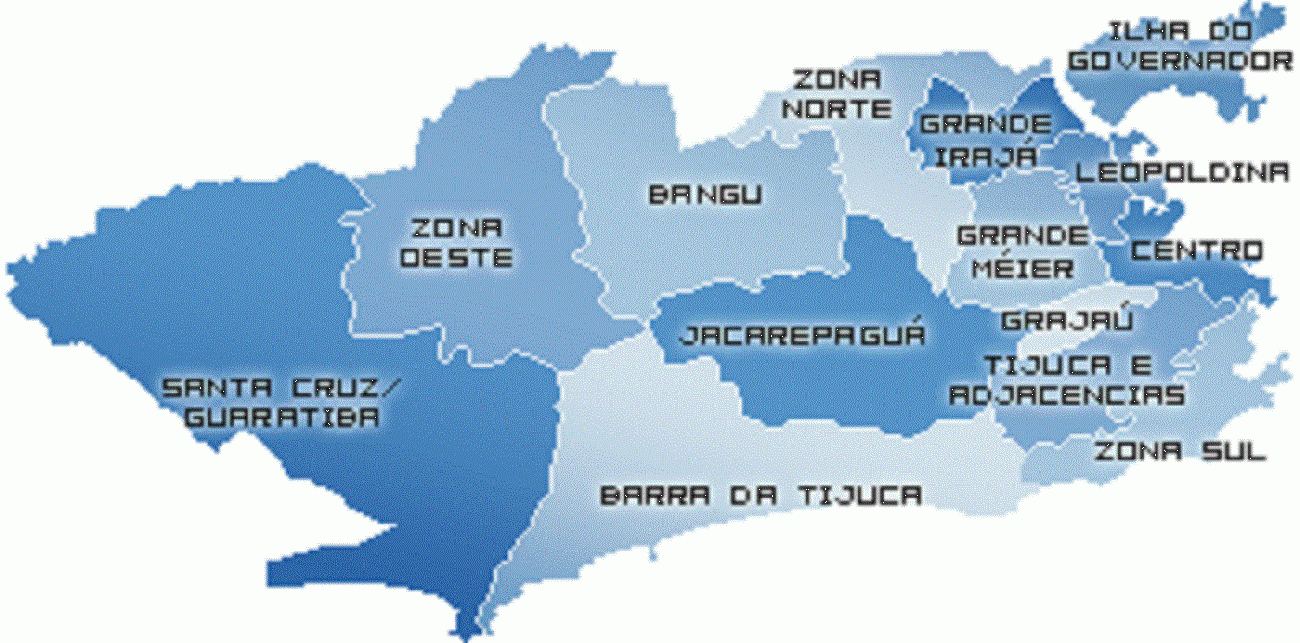
The North Zone begins at Grande Tijuca (the middle class residential and commercial bairro of Tijuca and its surrounding neighborhoods and favelas), just west of the city center, and sprawls for miles inland until Baixada Fluminense and the city's Northwest.
This region is home to the Maracanã stadium (located in Grande Tijuca), once the world's highest capacity football (soccer) venue, able to hold nearly 199,000 people, as it did the World Cup final of 1950. In modern times its capacity has been reduced to conform with modern safety regulations and the stadium has introduced seating for all fans. Currently undergoing reconstruction, it has now the capacity for 90,000 fans; it will eventually hold around 80,000 people. Maracanã was site for the Opening and Closing Ceremonies and football/soccer competition of the 2007 Pan American Games, and will host the final match of 2014 FIFA World Cup and the Opening and Closing Ceremonies and football matches of the 2016 Summer Olympics. Tijuca Forest in the city.
Besides Maracanã, the North Zone of Rio also holds other tourist and historical attractions, such as 'Manguinhos', the home of Instituto Oswaldo Cruz, a centenarian biomedical research institution with a main building fashioned like a Moorish palace, and the beautiful Quinta da Boa Vista, the park where the historic Imperial Palace is located. Nowadays, the palace hosts the National Museum, specializing in Natural History, Archaeology, and Ethnology.
The International Airport of Rio de Janeiro (Galeão – Antônio Carlos Jobim International Airport, named after the famous Brazilian musician Antônio Carlos Jobim), the main campus of the Federal University of Rio de Janeiro at the Fundão Island, and the State University of Rio de Janeiro, in Maracanã, are also located in the Northern part of Rio.
This region is also home to most of the samba schools of Rio de Janeiro such as Mangueira, Salgueiro, Império Serrano, Unidos da Tijuca, among others. Some of the main neighborhoods of Rio's North Zone are Tijuca, which shares the Tijuca Rainforest with the South and Southwest Zones; Água Santa, Vila Isabel, Méier, São Cristovão, Madureira, Penha, Manguinhos, Fundão, among others.
Many of the Rio de Janeiro's roughly 1000 shantytowns, or favelas, which makes it resembling many other cities in underdeveloped and developing countries, are located in Zona Norte.
Zona Oeste
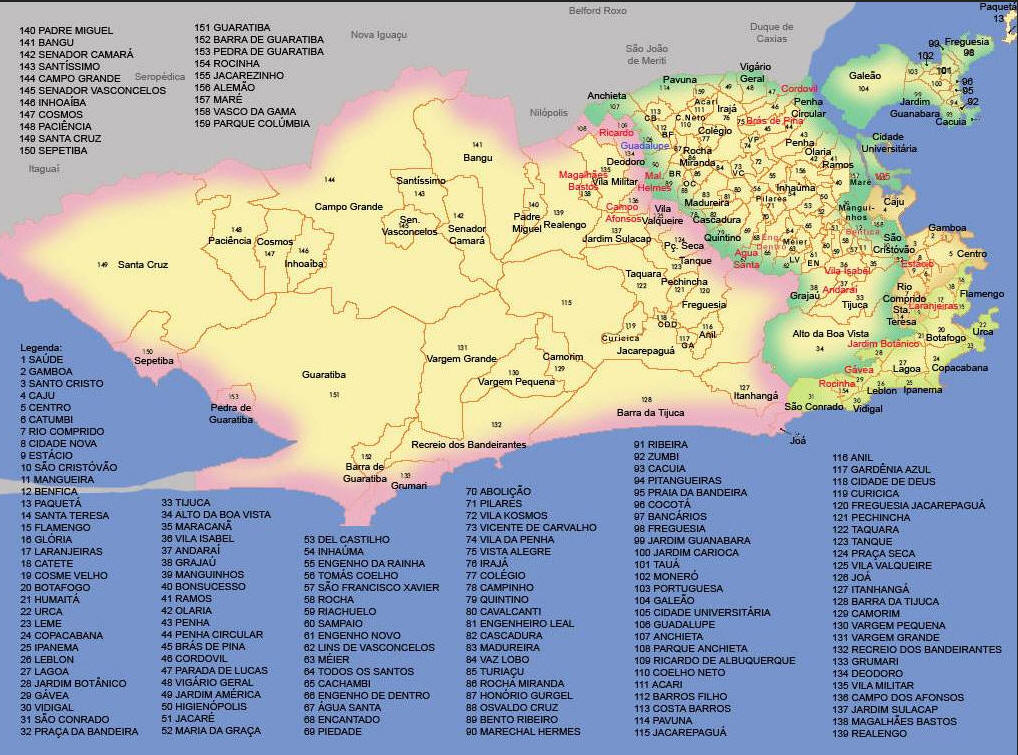
The West Zone of the city of Rio de Janeiro makes up about 50% of the city area. It has two areas with very different characteristics: the southern part of West Zone is a rich area, considered an extension of the South Zone. The northern part of the West Zone is a suburb, considered an extension of the North Zone.
Southern Region -- Barra da Tijuca
This area is the most recently modernized region of Rio de Janeiro. It includes Barra da Tijuca, Recreio dos Bandeirantes, Vargem Grande, Vargem Pequena, Grumari, Jacarepaguá as well minor neighbourhoods close to those cited here. There is a clear social contrast between this area and the Campo Grande/Santa Cruz area. Nevertheless, this area has its own favelas, such as Cidade de Deus, outlying the middle and upper class areas.
Westwards from the older zones of Rio, Barra da Tijuca is a flat complex of barrier islands of formerly undeveloped coastal land, which constantly experience new constructions and developments. It remains an area of accelerated growth, attracting some of the richer sectors of the population as well as luxury companies. High rise flats and sprawling shopping centers give the area a far more American feel than the crowded city centre.
The urban planning of the area, made in the late 1960s, resembles that of United States suburbs, through mixing zones of single-family houses with residential skyscrapers. The beaches of Barra da Tijuca are also popular with the city's residents. Barra da Tijuca is the home of Pan-American Village built for the 2007 Pan American Games.
The highest hill in Rio is Pedra Branca peak (Pico da Pedra Branca), in Barra da Tijuca region, and one of the most famous hills in the city is the 842 metres (2,762 ft) high Pedra da Gávea (Crow's nest Rock) near South Zone. On the top of its summit is a huge rock formation (some, such as Erich von Däniken in his 1973 book, "In Search of Ancient Gods", claim it to be a sculpture) resembling a sphinx-like, bearded head that is visible for many kilometers around.
This is the area of the City that will hold most of the sports venues and competitions during the 2016 Summer Olympic Games. It will be home to the Olympic Village, Olympic Beach, and Olympic Park as well.
Northern Region -- Campo Grande / Santa Cruz
This area is separated from the Barra da Tijuca by the Maciço da Pedra Branca and the Serra da Grota Funda. It has exhibited economic growth, mainly in the Campo Grande neighborhood. New industrial enterprises are being built in contemporarily lower and lower middle class residential Santa Cruz, one of the largest and most populous Rio de Janeiro's neighborhoods, most notably Companhia Siderúrgica do Atlântico (CSA), a new steel mill with its own private docks on Sepetiba Bay, planned to be South America's largest steel works. A tunnel called Túnel da Grota Funda, projected to open to traffic until May 2012, will diminish the time of access to the region from other areas of Rio de Janeiro and create a public transit facility between Barra da Tijuca and Santa Cruz.
A História do Rio
Europeans first encountered Guanabara Bay on January 1, 1502 (hence Rio de Janeiro, "January River"), by a Portuguese expedition under explorer Gaspar de Lemos captain of a ship in Pedro Álvares Cabral's fleet, or under Gonçalo Coelho. Allegedly the Florentine explorer Amerigo Vespucci participated as observer at the invitation of King Manuel I in the same expedition. The region of Rio was inhabited by the Tupi, Puri, Botocudo and Maxakalí peoples.
Several years after the Portuguese first explored Brazil, French traders in search of pau-brasil (a type of brazilwood) reached the rich area extending from the Cape Frio coast to the beaches and islands of Guanabara Bay, the economic and, above all, strategic importance of which was already well-known.
In 1555, one of the islands of Guanabara Bay, now called Villegagnon Island, was occupied by 500 French colonists under the French admiral Nicolas Durand de Villegaignon. Consequently, Villegagnon built Fort Coligny on the island when attempting to establish the France Antarctique colony, which the French called Henriville in honor of Henry II of France.
The Portuguese wanted to expel the French from that part of the South American coast which had been granted to them by the Treaty of Tordesillas. The task was given to Estácio de Sá, a nephew of Gov. Mem de Sá of Brazil, who in 1565 occupied the plain between Dog Face Hill (Morro Cara de Cão) and the Sugar Loaf and Urca mounts, thus laying the foundations of the future town of Rio de Janeiro. After two years (1565–67) of bloody battles, in which Estácio de Sá was killed and the French expelled, Mem de Sá chose a new site for the town, farther inland on the coast of the bay, at the top of the Hill of Rest (Morro do Descanso), or St. Januarius Hill (São Januário), later called the Castle Hill (Morro do Castelo). In 1568 the settlement was laid out in the form of a medieval citadel, protected by a bulwark and cannons.
The surrounding fertile land, allotted to Portuguese settlers by the Portuguese king in enormous plots called sesmarias, was planted with sugarcane, which was to provide the colony with its main source of income. In 1660 the community became the seat of the government of the southern captaincies (Portuguese administrative units) of Brazil. In the second half of the 17th century, the captaincy population grew to 8,000 inhabitants, two-thirds of whom were probably African slaves and Indians.
At the beginning of the 18th century, Brazil began to engage in gold and diamond mining, which brought about remarkable changes in the colony's economy and stimulated a great migration from Europe, thereby increasing the number of people of European ancestry. The former village became a town of 24,000 in 1749. When the colonial capital was transferred from Bahia to Rio de Janeiro in 1763, the town expanded farther, far beyond its walls. The remains of the monumental Roman-style aqueduct Arcos ("Arches") built at this time still stand in the city.
At the end of the 18th century, the town's economy, as well as that of the colony as a whole, was in a crisis because of the decline of the mines and competition from Central America for the world sugar market. In 1796 the value of exports from Rio's port was less than half of what it had been in 1760.
Coffee production and the resettlement of the Portuguese royal family in Brazil in 1808 again brought prosperity to the colony. By 1815, when Brazil became a kingdom, Rio de Janeiro was large enough to accommodate a foreign population. At about that time the city's original appearance was being transformed; from 1808 to 1818 some 600 houses and 100 country houses were built, and many older buildings were restored. Many streets were lighted and paved, more land was reclaimed, new roads were opened, and new public fountains were installed. Among new institutions established were the Royal Press, the Royal Library, the Theatre of Saint John, the Academy of Fine Arts, the Botanical Garden, and the Bank of Brazil. When King John VI returned to Portugal in 1821, Rio had almost 113,000 inhabitants and 13,500 buildings, and the town had extended both northward and southward. A year later Brazil was independent.
Expansion of coffee plantations in the State of Rio de Janeiro gave a new impulse to the city's development. Nobles and bourgeois moved their residences north to the São Cristóvão district. Merchants and English bankers chose to live around the Outeiro da Glória and Praia do Flamengo areas in the south, or they established their residences in the nearby Botafogo and Laranjeiras districts. The French, on the other hand, lived in country houses scattered in the Tijuca area farther westward.
In that era, as Brazil expanded its world export trade in such products as coffee, cotton, sugar, and rubber, the city changed its appearance, and the traces of its colonial past were effaced. In 1829 oxcart traffic was banned from the Rua do Ouvidor, then the city's most elegant street. In 1838 the first public transportation—horse-drawn buses—began to run to the districts of São Cristóvão, Engenho Velho, and Botafogo. In 1868 the first tramcars, also drawn by animals, were introduced. A steamboat service to Niterói began to operate in 1835. The first railroad was built in 1852 to Petrópolis, and a line reached Queimados in the Nova Iguaçú area in 1858. In 1854 gas replaced oil for street lighting, and wireless telegraphy was inaugurated. Sewerage was installed in 1864, and telephone service began in 1877.
When Rio de Janeiro, which had formerly been the capital of the empire, became capital of the republic of Brazil in 1889, it was already a considerable community. At the time of the 1890 census, it had more than 520,000 inhabitants on 61 square miles (158 square km), ranking it as the largest city in Brazil and one of the larger cities in the world. The 1891 constitution designated it the Federal District. Rio in 1889.
During the federal administration of Pres. Francisco de Paula Rodrigues Alves, from 1902 to 1906, Rio de Janeiro was further transformed. A team of administrators and technicians drained swamps, cleared slums, paved and widened streets, and markedly improved health conditions, notably by reducing cases of yellow fever and smallpox. The central avenue (called Avenida Rio Branco from 1912), still the most important of the Centre, was opened during that period; Avenida Beira-Mar, running parallel to part of the south shore, was built on reclaimed land; and several other important avenues were opened.
The population of the Federal District exceeded 1,000,000 by 1920 and increased to 1,750,000 by 1940. During that period the number of industrial establishments in the Federal District nearly trebled. Castle Hill was demolished, land reclamation increased the area in the Centre, and the first skyscrapers appeared. Streetcar lines, now moved by electrical power, multiplied. While settlement spread on the east coast, some areas to the north lost status, such as São Cristóvão, which became an industrial and lower-class residential neighborhoods.
In the mid-20th century, metropolitan Rio de Janeiro grew beyond its formerly narrow confines because of migration from other parts of Brazil, as well as a high rate of natural increase. The suburban population more than tripled to some 1.5 million between 1940 and 1960, at a time when the city proper exceeded 3.3 million. Following the transfer of the national capital to Brasília in 1960, Rio's rate of population growth slowed somewhat, although the suburban population continued to mushroom. By 1980 there were more than 5 million residents in the city and 3.6 million in the suburbs. Although subsequent growth continued at a lesser rate, by the early 21st century the metropolitan population exceeded 11 million, of which nearly half resided in the suburbs.
Beginning in the latter part of the 20th century, population growth, real estate speculation, and an amplified dependence on automobiles precipitated a series of changes in the city. The highway system was expanded, with improved access to numerous suburban areas; still higher skyscrapers arose in the Centre; and larger residential towers increasingly replaced small apartment buildings and houses. Landowners, the industrial sector, and the financial sector favored the changes; however, higher rents forced many poorer residents to move from the central city to the periphery or to the rapidly expanding favelas on the steeper hillsides. Meanwhile, many affluent families settled in the southwest, notably in Ipanema and Leblon and at sites farther down the coast.
Rio has maintained its status as the second largest manufacturing center in Brazil, after São Paulo. In addition, Rio's service sector remains one of the strongest in the country, providing for increasing numbers of jobs in such areas as finance, communications, tourism and entertainment, public and private education, and computer engineering. Rio remains a major center for cultural exhibitions and international conferences, and many of the more affluent and influential Brazilians keep homes there. Despite desperate conditions in the city's favelas, as well as high rates of violent crime throughout the city, grave levels of air and water pollution, and myriad other problems, Rio de Janeiro is still widely recognized as one of the world's more beautiful urban centers.
A população da Cidade
- -- Municipality: 11,093,472 = Census of 2031
- -- Urban Area: 16,721,890 = Census of 2031
- -- Metro Area: 17,876,286 = Census of 2031
As massas mortais da Cidade
- -- Amílcar Barros -- Senior Master of the Guild of Pickpockets of the Marvelous City
- -- Diniz Machado -- Senior journeyman pickpocket and rival of Hugo Satrix.
- -- Father Modesto Gaspar -- Catholic Priest of the Aguas Amarelas Favella.
- -- Leandro Almeida -- Local beat cop in Brenda & Jason's region.
- -- Félix Nicolau Araújo -- Rio attorney
- -- Dr.Antónia Cruz -- Police psychologist (lesbian)
- -- Rebeca Vargas -- Cassandra's police partner
- -- Marcelino Duarte -- Embalmer at the Campos Verdes Mortuary
- -- Helder -- A Nosferatu ghoul.
- -- Diogo Mata -- Small time car thief
- -- Jean-Baptiste Paquet -- Eldest brother of a French tourist family.
- -- Élodie Couture-Paquet -- The wife of Jean-Baptiste and mother of Raphael.
- -- Raphael Paquet -- Son of Jean-Baptiste and Élodie.
- -- Bonifacio Pinheiro -- A local parish priest.
- -- Clara Rodrigues -- Police Investigator and partner to Cassandra Fonseca
- -- Rogério -- Local Teen Crime-lord
- -- Tereza Branca Romão -- Reporter for one of the local hot-sheet rags.
- -- Jacinta Silva -- Campos Verdes Mortuary Owner
- -- Octávio Souza - Apostador Profissional
Arenas
Atrações
Castelos na Cidade
Cemitérios (cemeteries)
Governo da Cidade (city government)
Organizações Criminosas (criminal organizations)
- -- Cobras Pretas -- A rising local gang that has rather recently gotten into the business of snuff-porn.
- -- Escorpiões -- A local street gang with recent access to military grade small arms.
- -- Guild of Pickpockets of the Marvelous City -- A recently formed, but tightly knit cartel of picket-pockets in Rio.
- -- Yakuza -- Japanese organized crime in Rio.
Current Events
Galleries
Hospitals
Hotels & Hostels
Hypermarkets
Landmarks
Maps
Market Places
Monuments
Museums
Parks
Private Residences
Restaurants
Ruins
Schools
Shops
Terra Santa (holy ground)
- -- Monastery of Saint Benedict of Rio de Janeiro (Sao Bento Monastery)
Theatres
Transportation
Vida Noturna (nightlife)
Discussion: The nightlife and club scene in Rio de Janeiro are spread out, more or less, into three specific districts: the lower Zona Sul (south zone), the upper Zona Sul and Centro (downtown). The lower Zona Sul is broken down into four neighborhoods: Copacabana, Gavea, Ipanema, and Leblon. The upper Zona Sul is broken down into the neighborhoods of Botafogo, Laranjeiras, Flamengo. Of course, there is also Centro which consists of the neighborhoods of Centro and Lapa.
The lower Zona Sul is the more affluent of the three disticts and attracts the wealthy locals and upper class tourists. Each nightclub has a cover and that admission fee can vary from 30 Reals (Brazilian monetary unit) up to 120 Reals. An interesting feature of Rio nightlife is that often, the cover fee acts as a sort of credit card, allowing the club-crawler to drink up to his cover charge without spending anything else. Currently, the most recommended clubs are Nossa Semhora in Copecabana, Conversa Fiada, Books and Baronetti in Ipeanema, Melt in Leblon and Zero-Zero in Gavea.
The upper Zona Sul is less affluent than the lower southern zone, but there are plenty of good opportunities if one has the patience to search for them. The primary clubs are: Casa Rosa in Laranjairas, and Casa do Matriz in Botafogo. The cover charge can range from 10 to 30 Reals and these places have a distinct house-party atmosphere and are quite informal.
- -- Conversa Fiada (Copecabana)
- -- Nossa Semhora (Copecabana)
- -- Baronetti (Ipeanema)
- -- Books (Ipeanema)
- -- Melt (Leblon)
- -- Zero-Zero (Gavea)
- -- Casa Rosa (Laranjairas)
- -- Casa do Matriz (Botafogo)
- -- Casa Merda (a dangerous place located in a nearby Favela)
http://www.mavericktraveler.com/rio-de-janeiro-nightlife-guide/
http://www.bing.com/search?q=rio+de+janeiro+clubs+guide&pc=MOZI&form=MOZSBR
Os vampiros da Cidade Maravilhosa
- As Leis da Cidade - The Laws of the City
- The Law of Carnival
- Rio de Janeiro is a Free City - Free from the War of Ages.
- Within the City - There are no sects and no resident may claim allegiance unto them.
- The Penalty - Ignorant violation means banishment, knowing contravention is the final death.
Os Salões da Sociedade Noite - The Salons of the Night Society
Os Tribunais de os Cariocas: The Blood Courts of Rio
 O Tribunal de Rosas: The Toreador {6}
O Tribunal de Rosas: The Toreador {6}
- -- Léonide Évariste de la Croix -- O Rei do Carnaval (the king of the carnival)
- -- Efigénia Campos -- O Cavaleiro da Rosa (knight of the roses)
- -- Leonardo Ferreira -- Toreador armorer and smith
- -- Zezé Rios -- Bardo das Areias
- -- Brenda Maier -- Officially, progeny of Zezé Rios.
- -- Fiacre Sauvageot -- The Savage Swan -- Toreador antitribu
A Corte das Sombras: The Lasombra {6}
- -- Calixta Narcisa de Torres -- Rainha do Carnaval (queen of the carnival)
- -- Cristóvão de Silva -- O Cavaleiro das Trevas (knight of the shadows)
- -- Pai Celestino -- O Sacerdote de Cinzas (the ashen priest)
- -- Anacleto a Astúcia -- -- O Feiticeiro das Sombras (the wizard of shadows)
- -- Wilfredo Rosario -- -- O Filho Pródigo (the prodigal son)
- -- Fabiana Belo --
Os Tribunais de Menores: The Lesser Court of Blood
Os Animais - Beasts
- -- Vasco Almeida
- -- Dudu
Os Cobras - Snakes
- -- Danilo Palmeiro (deceased - April 2006)
 Os Enganadores - Deceivers
Os Enganadores - Deceivers
- -- Angélica Pinho
- -- Hugo Satrix -- Master Pick-pocket
Os Feiticeiros - Sorcerers
Quote: "Always two, there are. No more, no less. A master, and an apprentice." -- Yoda -- Episode I: The Phantom Menace.
- -- Úrsula Henriques -- Regent of Rio de Janeiro
- -- Kenshin Kita -- The Japanese Apprentice
Os Leprosos - Lepers
- -- Pai Celio -- Leper Priest
- -- Emily Elliott -- Rica
Os Necromantes - Necromancers
Os Sangues Azuis - Blue Bloods
- -- Therèse Maurier -- Elder of Ventrue of Rio de Janeiro.
- -- Severina Belo (antitribu)
- -- Clementina Ventura (antitribu)
- -- Marisa Gomes (antitribu)
 Os Sarracenos - Saracens {7}
Os Sarracenos - Saracens {7}
- -- Ridha Kader -- Moroccan Elder (warrior caste)
- -- Nsia Abena -- African Akan Neonate (warrior caste)
- -- Fatmir Baris -- Albanian Ancilla (warrior caste)
- -- Eren Demir -- Turkish Neonate (sorcerer caste)
- -- Jason Maier - The Dark Knight -- The Rio Chronicles - Jason (vizier caste)
- -- Christinana Guillory - Jason's First Childe (vizier caste)
- -- Anselmo - Nicknamed: A Barata -- Assamite antitribu (warrior caste)
Tzimisce - Fiends {1}
- -- Gabi Alexandrescu -- The Sabbat Ettin
Os Tolos - Fools
- -- Mister Cocoa -- And of course, his evil White Rabbit!
 Os Guardas da Lei: The Brujah: The Order of the Constabulary
Os Guardas da Lei: The Brujah: The Order of the Constabulary
- -- Netuno
- -- Salomão Machado -- Elois sire of the neonate Cassandra Fonseca
- -- Cassandra Fonseca -- Brujah Cop and childe of Salomão Machado
- -- Luitger Fürst - German Expatriate (Late 2016)
- -- Kayetan Schulte -- German Officer & S.S. Doctor
Os Bastardos do Rio - The Caitiff
- [[]]
- Name:
- Sobriquet:
- Appearance:
- Background:
- Domain:
- Personality:
- Current Events:
Estrangeiros do Sangue - Foreign Vampires
As Sociedades Estranhas - The Sects
Aqueles caído para a Segunda Morte - Those who have fallen to the Second Death
- [[]]
- Name: Don Fidel Ismael Maximiliano de Lisbon
- Sobriquet:
- Appearance:
- Background:
- Domain:
- Personality:
- Demise:
Contos de Mortos-Vivos - Stories of the Kindred
- A Letter for the King - September of 2001
- Along Came A Spider - Summer 2002
Os Outros: The Others
- -- Octavia -- Ananzi party-girl
- -- Jurou Yukimura -- Yakuza front-man in Rio de Janeiro & Kuei-jin
Um Léxico: The Dictionary
Baile: A dance party hosted by a local favelas.
Bairro: Portuguese for neighborhood.
B.O.P.E: In Portuguese (Batalhão de Operações Policiais Especiais), the Special Police Operations Battalion of the Rio de Janeiro Military Police.
Cariocas: The residents of Rio de Janeiro.
Cemitério: Portuguese for cemetery.
Favela: is the generally used term for a shanty town in Brazil.
Favelização: "favela growth" or "favelisation".
Moradores da favela: The term used for those who live in the favelas, also known pejoratively as favelados.
Websites
http://travel.nationalgeographic.com/travel/city-guides/rio-de-janeiro-walking-tour-1/
http://www.myanmarvisa.net/best-places-to-live-in-rio-de-janeiro/
http://www.riojiujitsuguide.com/rio-neighborhood-guide/
http://marciokenobi.wordpress.com/category/cities/
http://en.wikipedia.org/wiki/Rio_de_Janeiro
